Scientists aim to catalogue tropical island from mountaintops to seafloor
Scientists aim to catalogue tropical island from mountaintops to seafloor
Roberta Kwok, special to mongabay.com
June 4, 2008
|
|
Scientists are launching an effort to catalogue a complete tropical ecosystem, the first time anyone has attempted such an ambitious undertaking. Led by researchers at the University of California, Berkeley, a U.S.-French team plans to collect DNA “barcodes” for every animal, plant, and fungus on the small island of Moorea in the South Pacific, scouring habitats from coral reefs to high-reaching cloud forests. The island could eventually serve as a model for how ecosystems respond to stresses such as climate change, invasive species, and pollution.
Moorea is part of an archipelago in French Polynesia, about 15 kilometers (nine miles) northwest of Tahiti. Scientists have studied Moorea for decades at two field stations, the Berkeley-run Richard B. Gump South Pacific Research Station and France’s Centre de Recherches Insulaires et Observatoire de l’Environnement. Because the island is isolated, relatively few organisms have arrived on Moorea, with only about 5,000 species recorded so far. It’s also small, about the size of the city of San Francisco. This compact setting, and its low diversity compared to other Pacific islands, makes Moorea a tractable choice for a comprehensive catalogue, the scientists say.
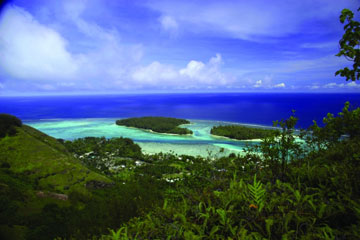 A bird’s-eye view of Moorea, part of an archipelago in French Polynesia. Photo by Erica Spotswood. |
Leading the effort is an international team that includes scientists from Berkeley, the Smithsonian Institution in Washington, D.C., the Centre National de la Recherche Scientifique in France, and the Delegation a la Recherche in French Polynesia. With a $5.2 million grant from the Gordon and Betty Moore Foundation of California, the researchers will spend three years combing the island and its surrounding waters for every species they can find. Team members already collected almost 2,000 fishes, geckos, marine invertebrates, and insects during a 2006 pilot project to show that they were up to the task.
“They did an amazing amount of work,” said David Kingsbury, chief program officer for the Moore Foundation’s science program, in an interview with mongabay.com. “If they really do define a model ecosystem where they know all the components, that’s going to be a major accomplishment in ecological science.”
Tropical biodiversity: the ultimate challenge
The Moorea Biocode Project (MBP) relies on a new and controversial technique called DNA barcoding. To generate a barcode, scientists take a DNA sample from an organism and sequence one gene. The default gene, named COI, is found in a quickly evolving type of DNA called mitochondrial DNA. Because almost all species have this gene, but slightly different versions, it can be used to distinguish one species from another. The more different two copies are, the less related the species are likely to be.
While the use of genetic techniques to analyze species differences is not new, barcoding offers a simpler, more standardized approach that will allow the researchers to tackle an entire ecosystem quickly. By barcoding on a large scale, the team hopes to paint a more complete picture of the island’s biodiversity. This knowledge could help scientists understand how many species are actually at risk.
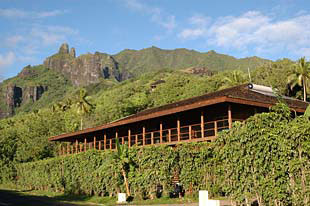 Scientists have been studying Moorea at Berkeley’s Richard B. Gump South Pacific Research Station since 1985. Photo by Gustav Paulay. |
“If you don’t know what’s out there, you don’t know what you’re losing,” said Chris Meyer, the MBP program director and a zoologist at the Smithsonian Institution, in an interview with mongabay.com. “We don’t know the diversity on the reefs. It’s kind of embarrassing. Are there 500,000 species, or five million? We really don’t know.”
Understanding tropical ecosystems is especially important because they have some of the highest diversity, said Neil Davies, executive director of the Gump Station and MBP’s principal investigator.
“If you want to understand biodiversity, the tropics represent the ultimate challenge,” said Davies. “Ultimately, we need to come to grips with how to manage high-diversity ecosystems sustainably. Most of the scientific effort has been concentrated in temperate zones. And yet tropics are where most of the people and arguably where most of the problems are. We’re trying to redress that balance in a small way.”
Moving beyond the microscope
The team will begin its project in earnest in June, when scientists will collect a small test set of marine invertebrates. In late summer and fall, more teams will arrive to catalogue terrestrial invertebrates, marine algae, and fungi. By the end of the three-year project, the team expects to find between 7,500 and 15,000 species, with as many as one-fifth being completely new. The researchers will enter the DNA sequences, along with photographs of each organism, into a publicly accessible database.
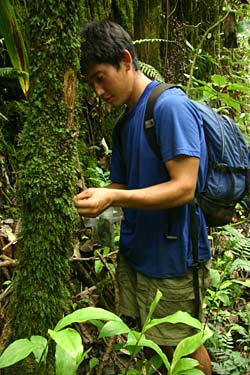 The Moorea Biocode Project team plans to collect DNA from every plant, animal, and fungus on the island. Here, Berkeley undergraduate Joel Nitta samples a fern. Photo by Erica Spotswood. |
The team’s efforts have already impressed other scientists. Giacomo Bernardi, a marine biologist at the University of California, Santa Cruz who is not affiliated with the project, was in Moorea during the pilot study and saw the team’s initial findings.
“They have discovered so many new species, it’s unreal,” said Bernardi. “I have been going to Moorea since 1992, so I know the fishes of Moorea well enough. And they showed me a lot of species that I have never seen.”
Bernardi says the data will help his research on marine larvae, the immature forms of sea creatures that were previously almost impossible to identify. Instead of straining to pick out a larva’s features under a microscope, he will be able to process hundreds of larvae by simply checking their DNA against the barcode database. Being able to identify larvae will help scientists make more informed decisions about marine protected areas, he says. For instance, if larvae from a certain species are found in an area, scientists can say with confidence that the area protects that species.
A blunt instrument?
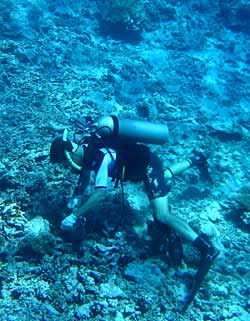 Program director Chris Meyer dives to the seafloor for marine invertebrates. Photo by Jim Hayward. |
Other scientists are more critical of the barcoding approach. Kendall Clements, a marine biologist at the University of Auckland in New Zealand, says barcoding doesn’t work unless researchers have already studied many individuals from the same species and figured out how much their DNA tends to vary. For instance, if a species has an unusual amount of genetic difference among its members, two individuals from the same species might look like different species. Since species can also vary greatly across different locations, he says, sampling just from Moorea will present an overly simplistic picture.
“Biocoding everything is a very blunt instrument,” said Clements. “Fundamentally, you can’t use biocoding for species discovery except in the very crude sense. It really only works if you know the answer already.”
Meyer says the team plans to sequence more genes later, which will improve the species identifications. He agrees that barcoding isn’t always accurate but is still a powerful tool.
“The barcode is a proxy, period,” said Meyer. “Even when you’re wrong, you’re not going to be that wrong. You’re going to be on the right page of the encyclopedia. It works incredibly well as an index to all that diversity of life.”
Putting the barcodes to work
The team plans to zero in on a few scientific questions to test the usefulness of the barcode data. Two MBP co-investigators from Berkeley, George Roderick and Craig Moritz, will re-construct a food web based around spiders and lizards, using DNA tests to identify the contents of animals’ guts. By figuring out the diets of each organism, they hope to learn how an invasive species affects an ecosystem. For instance, an invasive predator might nudge out a native species because it eats a wider range of prey.
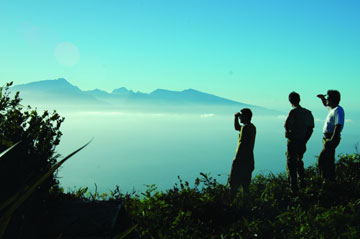 A plant collection team ascends Mount Tohiea, Moorea’s highest mountain. Photo by Dan Polhemus. |
The barcode database will also provide a genetic snapshot of the island that can be used to track disturbances to the ecosystem, such as climate change, sea level rise, and pollution. The knowledge gained at Moorea could eventually help scientists understand larger, more complex ecosystems.
“To look at these long-term effects, you need baseline studies,” said Roderick, a population biologist. “We can compare what happens over time as the sea level rises and the temperature changes. And based on what we find, we can make predictions for what people will find elsewhere.”
Davies hopes that the intensive study of a small island will jumpstart other discoveries in ecology, just as studying simple organisms brought about huge advances in medicine.
“We don’t understand enough about how ecosystems function,” said Davies. “We need the same kind of transformation of conservation and natural resource management through advances in science.”
Roberta Kwok is a graduate student in the Science Communication Program at the University of California, Santa Cruz.